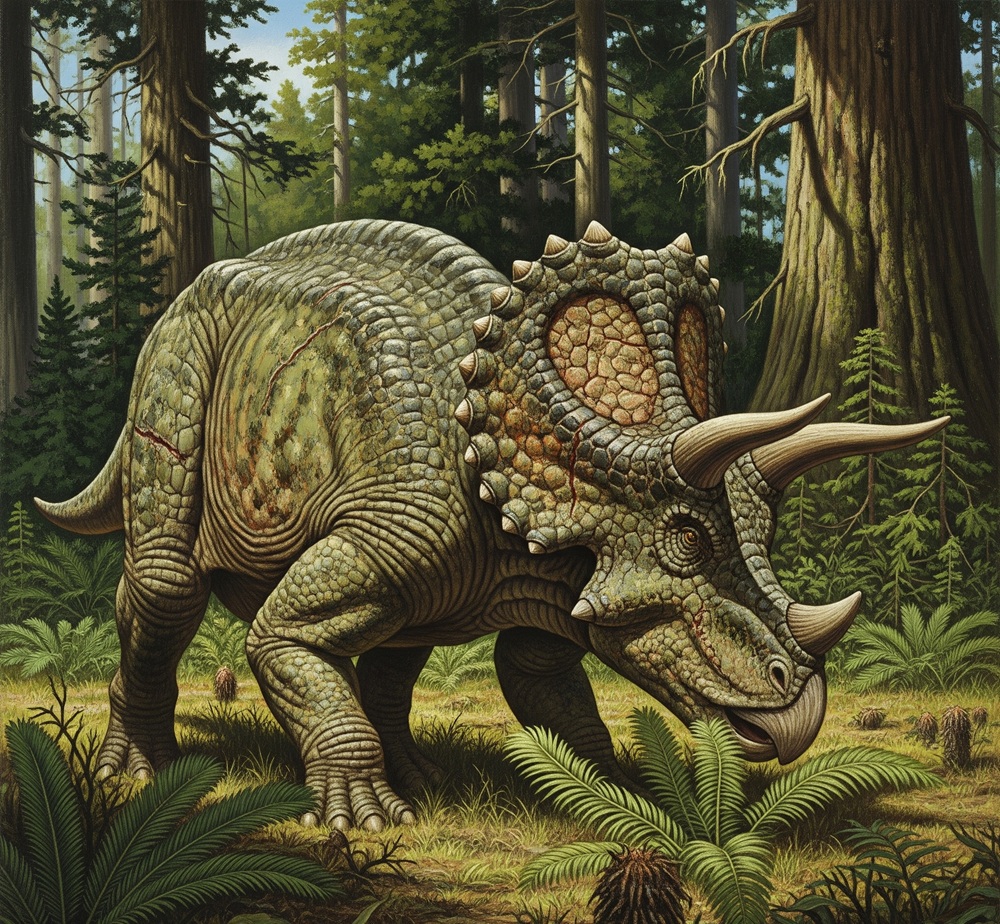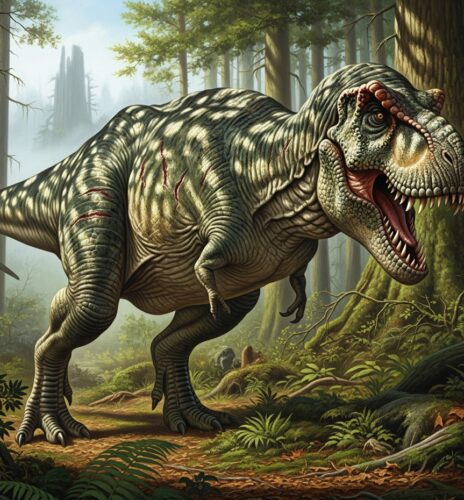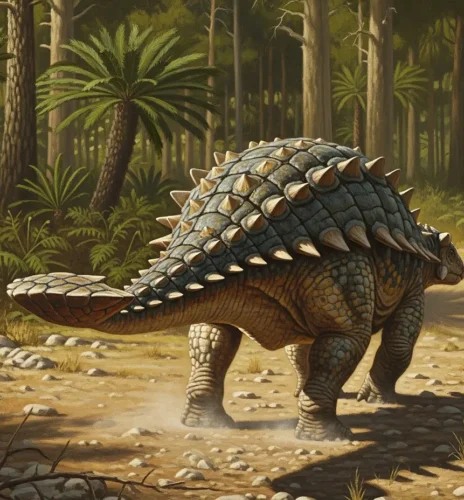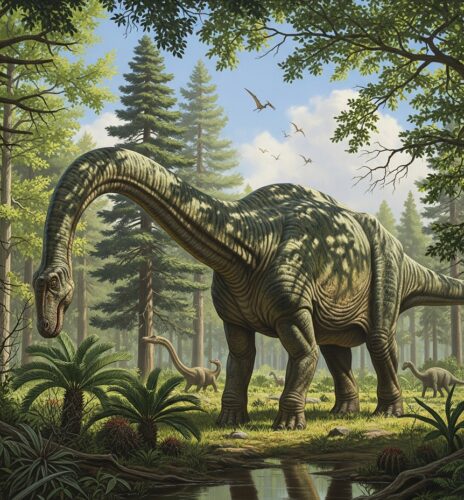When you picture a Triceratops, you likely see a heavily-armored herbivore locking horns with a ferocious Tyrannosaurus rex. While this epic struggle is a classic image from the Cretaceous period, the story of this three-horned face goes far deeper than just being a walking shield. With one of the most recognizable skulls in the fossil record, Triceratops was a truly unique dinosaur, and recent discoveries continue to challenge and refine our understanding of its life.
From its incredibly efficient dental system to its complex social life, here are five of the most interesting facts about the Triceratops and the new research that is bringing these magnificent creatures to life.
1. The Ultimate Plant-Eating Machine: Despite its formidable horns, Triceratops was a peaceful herbivore. However, its methods for consuming plants were anything but passive. It possessed a sharp, bird-like beak at the front of its mouth for snipping tough vegetation, and behind that, it had a “dental battery.” This was a set of hundreds of tightly packed teeth arranged in columns, which continuously grew new teeth to replace old, worn ones. This allowed it to grind down tough, fibrous plants like ferns and cycads with incredible efficiency, making it a master of its ecological niche.
2. A Skull That Was Both a Weapon and a Shield: The Triceratops skull is one of the largest of any land animal, measuring up to 2.5 meters (8 feet) long and weighing up to a ton. The iconic horns and bony frill were originally thought to be purely for defense against predators like T. rex. While they certainly could have been used to inflict a nasty wound, recent studies of injuries on fossilized frills suggest that the primary use was likely for combat with other Triceratops, much like bull elk sparring over mates or territory. This doesn’t mean it couldn’t defend itself—a Triceratops would have been an incredibly dangerous target—but it points to a more complex purpose for its elaborate cranial ornamentation.
3. From Solitary Wanderers to Social Animals: For many years, paleontologists believed that Triceratops lived solitary lives, as their remains were often found as single individuals. However, this idea has been challenged by a number of groundbreaking discoveries. The 2005 discovery of a group of three juveniles found together in Montana suggested that young Triceratops at least lived in groups. More recently, a trove of fossils in Wyoming unearthed in 2013 provided even stronger evidence. Over 1,200 bones from five individuals were found clustered together, proving that at least some Triceratops lived and died in herds. This new understanding has dramatically altered how we envision them in their natural habitat.
4. A Changing Face, and a Controversial Cousin: Like many animals, the skull of a Triceratops changed dramatically as it grew. Its horns began as small, backwards-curving stubs that grew and straightened as the animal matured. These changes led early paleontologists to classify different growth stages as entirely separate species. One of the most famous examples of this is the controversy surrounding Torosaurus, a ceratopsian with a large frill. A 2010 study suggested that Torosaurus was not a separate genus at all, but rather the fully mature, adult form of Triceratops. While this idea is still debated, it highlights how much we are learning about the growth and development of dinosaurs.
5. One of the Last Dinosaurs Standing: Triceratops was a true survivor. It was one of the last non-avian dinosaurs to roam the Earth, living right up to the end of the Cretaceous period. In fact, it’s very likely that individual Triceratops witnessed the catastrophic asteroid impact that led to their extinction 66 million years ago. Their fossils are some of the most common from this time, suggesting they were one of the dominant herbivores in their ecosystem, right to the very end.
Recent Discoveries and Findings
- A “Lost Relative” Found: In 2021, paleontologists announced the discovery of Sierraceratops turneri, a new species of horned dinosaur from New Mexico. While not a direct ancestor of Triceratops, its discovery helps to fill in the family tree of ceratopsian dinosaurs and shows that different species of horned dinosaurs evolved in distinct groups across North America. This suggests that the diversity of dinosaurs was higher than we previously thought.
- Evidence of Social Structures: As mentioned, the discovery of the five Triceratops fossils in Wyoming has been a major breakthrough. Detailed chemical analysis of their teeth revealed that all five individuals had the same migratory history, which strongly supports the herd theory. Researchers from the Naturalis Biodiversity Center in the Netherlands, who led the project, have also noted that the bones show the dinosaurs grew slowly over many years, hinting at a prolonged period of parental care and social cohesion.
- New Insights from “Big John”: The discovery of the Triceratops specimen nicknamed “Big John” in 2014 provided new insights into dinosaur behavior. The frill of this fossil shows a healed wound that was likely caused by another Triceratops horn, reinforcing the idea that they engaged in intraspecies combat. This kind of evidence allows scientists to move beyond speculation and base behavioral theories on concrete physical evidence.
The story of the Triceratops is not a simple tale of a defensive beast. It’s the story of a complex, social, and incredibly successful animal that adapted to its environment with a mix of biological innovation and brute strength. And with new discoveries always on the horizon, we can be sure that the fascinating story of the Triceratops is still being written.
Resources:
- Farke, A. A. (2004). Horn use in Triceratops (Dinosauria: Ceratopsidae): Testing behavioral hypotheses using scale models. Palaeontologia Electronica, 7(1):10A. https://palaeo-electronica.org/2004_1/horn/issue1_04.htm
- Scannella, J. B., & Horner, J. R. (2010). Torosaurus is not Triceratops: The view from the Hell Creek Formation. Journal of Vertebrate Paleontology, 30(5), 1409-1419.
- Dalman, S. G. et al. (2021). A new late Campanian ceratopsid dinosaur from the Hall Lake Formation of New Mexico and its implications for ceratopsid biogeography. Cretaceous Research, 126, 104938. https://www.bath.ac.uk/announcements/new-lost-relative-of-triceratops-found-in-new-mexico/
- De Rooij, J. (2024). ‘Jurassic Park’ Vindicated As Triceratops Shown To Have Lived in Herds. Newsweek. https://www.newsweek.com/triceratops-fossils-found-wyoming-herd-paleontology-1883523



